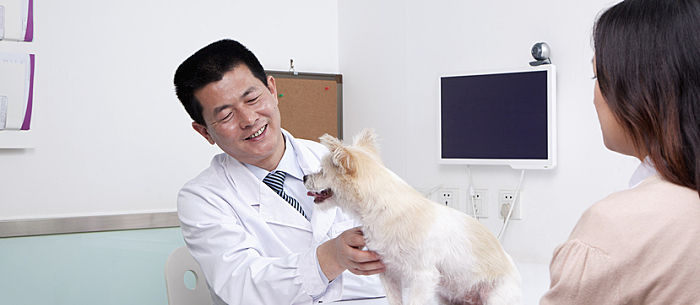You notice some symptoms, or your vet does on a routine visit: Your dog, it turns out, has a tumor. The first question that might come to mind when you hear of tumors in dogs is,”Is it cancer?” In 2011, that’s what Beth Baumann of Perris, California thought. She noticed that her Scottish Terrier, Winston, had extremely dry and flaky skin that the groomer found. The vet treated it as a skin condition, but eventually Winston started to drink excessively and lost control of his bladder.
It turned out that Winston had a cancerous tumor in his liver.
Because of his advanced age (he’s now 10), Baumann decided against chemotherapy, opting instead for a milder medication in pill form. “We decided on doing the pills because we saw a change once we started him on them. There weren’t as many risks as surgery, and it was easier to cope with financially.”
Baumann and Winston’s story is a common one. One thing is certain — finding out your dog has a tumor is devastating. But tumors in dogs aren’t always cancer, and most are removable. If you see something unusual on your dog or notice behavioral changes, go see your veterinarian immediately.
Here are five of the most common type of tumors in dogs:
- Lymphosarcoma
Tumors on your dog’s lymph nodes can be peripheral tumors, meaning they are outside of the body cavity. Enlargement of your dog’s lymph nodes is the most common sign. The area beneath your dog’s jawbone is often affected first, according to Dr. Carol Osborne, an integrative veterinarian.“Lymphosarcoma is the most common type of cancer in dogs today. Lymphosarcoma is also referred to as lymphoma and is the leading cause of canine death,” says Dr. Osborne. In some cases, you might have your dog’s tumor removed.
You might also try chemotherapy, which helps around 90 percent of dogs go into remission. Depending on the stage of the cancer, remission can last an average of nine to 12 months.
Internal lymphosarcoma are tumors on the inside your dog’s body cavity, with severe symptoms like vomiting, diarrhea, breathing problems and abdominal pain. Treatment includes chemotherapy and possible removal of the tumor depending on the location.
- Osteosarcoma
If your dog has a bone tumor, it is most likely to be osteosarcoma, which is malignant. This tumor spreads quickly and is usually found on the long bones of large breed dogs like greyhounds, according to the American Kennel Club’s Canine Health Foundation.Your dog might have lameness in the limb, as well as swelling. Usually the tumor can’t be removed because it spreads so fast. Amputation and chemotherapy are the best treatment options for your dog in this case and have the best survival rates.
- Mammary Carcinoma
Common among unspayed females, mammary tumors are cancerous in 50 percent of female cases, according to the American College of Veterinary Surgeons (ACVS). If your dog has this breast tumor, she may experience fatigue, weight loss, swollen breasts and decreased appetite.Your veterinarian will probably recommend surgery to remove the tumor or the entire mammary gland, according to the ACVS. If the tumor spreads to other areas, try chemotherapy. “Unlike humans, less than five percent of dogs experience serious side effects from chemotherapy,” says Dr. Osborne.
- Mast Cell Tumor
Of all the malignant tumors a dog can get, a mast cell tumor is the most common, according to The Veterinary Cancer Center. Mast cells are found in skin and other tissue and are part of the immune system, says the National Canine Cancer Foundation.You can notice the tumors because of swelling and redness with possible itchiness and hair loss at the spot. Removal is the primary treatment for these tumors, followed by radiation.
- Lipomas
Sometimes called fatty tumors, they’re slow growing and common in older dogs. They’re usually just under the skin and feel firm but slightly movable. They’re also benign, meaning not cancerous, according to Fetch a Cure. Always have them checked out by a vet, who’ll usually do a fine needle aspiration (inserting a needle into the mass to extract fluid to examine).Your veterinarian will take measurements and observe the tumor. If the mass makes your dog uncomfortable, it can be removed, but it’s not necessary.
Dr. Osborne says along with blood work, the first thing your vet will do is “stage” the cancer to determine how far it’s progressed. Treatment will vary based on what stage the cancer is at. Whatever you treatment you decide on, whether it’s pills like Baumann or surgery, your vet will be there for your family the entire way.
And read 5 Reasons a Dog Cyst Isn’t Cancer.
Margie Mars is the mother of eight, Oma of three and proud mom of a Chocolate Lab with OCD. She writes on a variety of topics for several websites including three top parenting sites, and you can follow her on twitter.
*This article is for general informational purposes only. It is not intended nor implied to be providing medical advice and is not a substitute for such advice. The reader should always consult a health care provider concerning any medical condition or treatment plan. Neither Care.com nor the author assumes any responsibility or liability with respect to use of any information contained herein.



